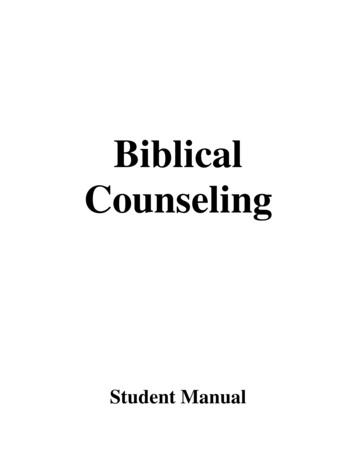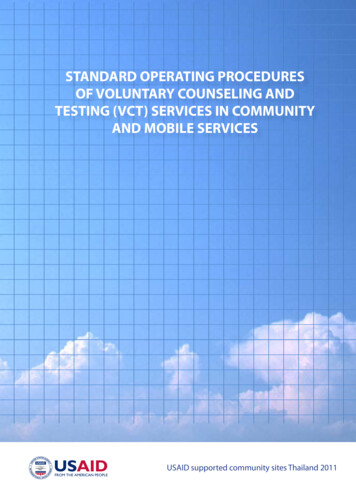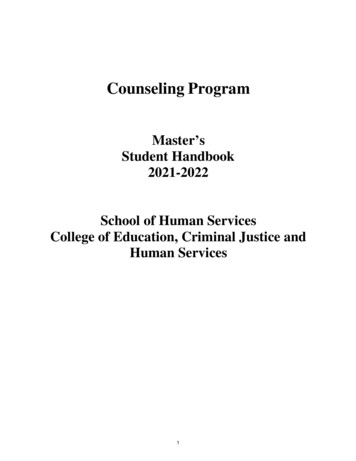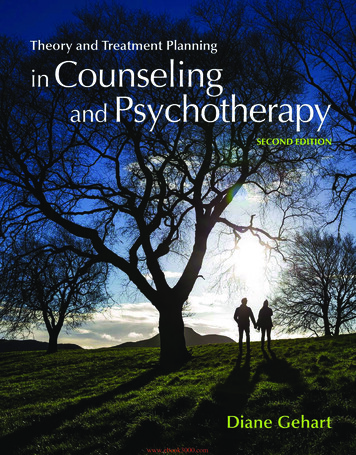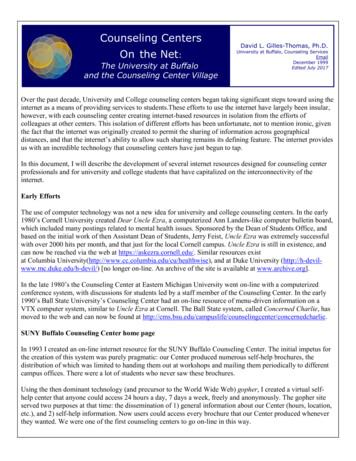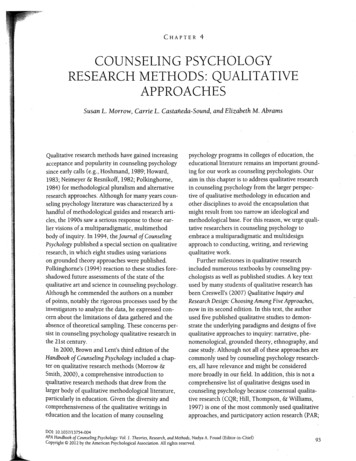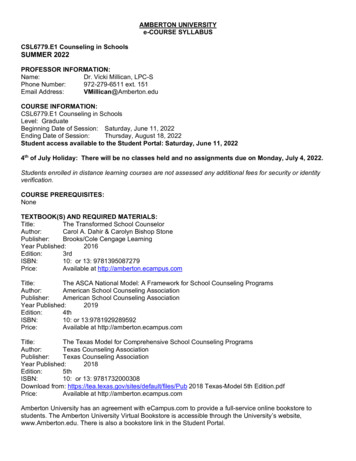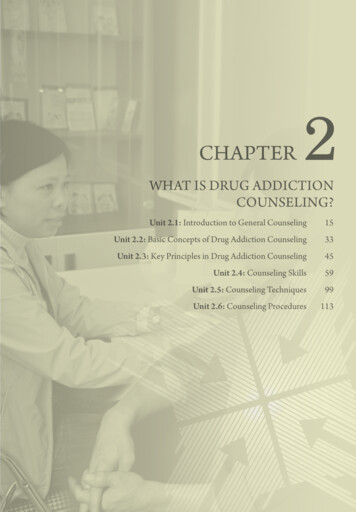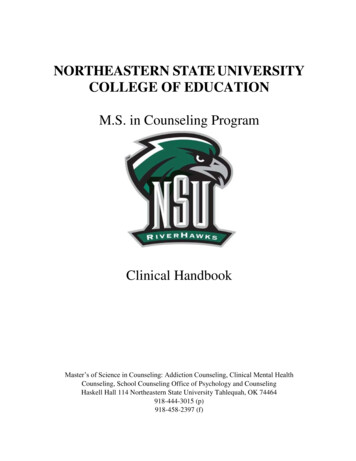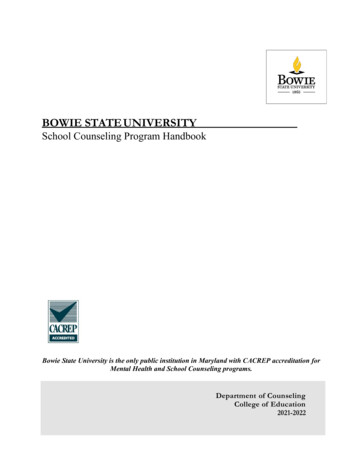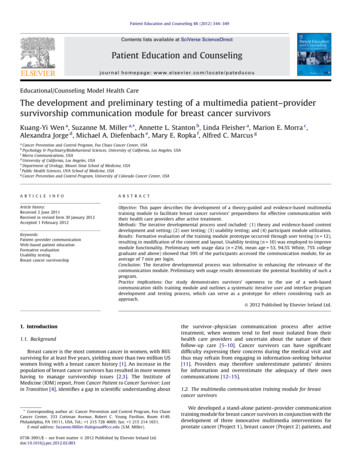
Transcription
Patient Education and Counseling 88 (2012) 344–349Contents lists available at SciVerse ScienceDirectPatient Education and Counselingjournal homepage: eling Model Health CareThe development and preliminary testing of a multimedia patient–providersurvivorship communication module for breast cancer survivorsKuang-Yi Wen a, Suzanne M. Miller a,*, Annette L. Stanton b, Linda Fleisher a, Marion E. Morra c,Alexandra Jorge d, Michael A. Diefenbach e, Mary E. Ropka f, Alfred C. Marcus gaCancer Prevention and Control Program, Fox Chase Cancer Center, USAPsychology & Psychiatry/Biobehavioral Sciences, University of California, Los Angeles, USAMorra Communications, USAdUniversity of California, Los Angeles, USAeDepartment of Urology, Mount Sinai School of Medicine, USAfPublic Health Sciences, UVA School of Medicine, USAgCancer Prevention and Control Program, University of Colorado Cancer Center, USAbcA R T I C L E I N F OA B S T R A C TArticle history:Received 2 June 2011Received in revised form 30 January 2012Accepted 1 February 2012Objective: This paper describes the development of a theory-guided and evidence-based multimediatraining module to facilitate breast cancer survivors’ preparedness for effective communication withtheir health care providers after active treatment.Methods: The iterative developmental process used included: (1) theory and evidence-based contentdevelopment and vetting; (2) user testing; (3) usability testing; and (4) participant module utilization.Results: Formative evaluation of the training module prototype occurred through user testing (n 12),resulting in modification of the content and layout. Usability testing (n 10) was employed to improvemodule functionality. Preliminary web usage data (n 256, mean age 53, 94.5% White, 75% collegegraduate and above) showed that 59% of the participants accessed the communication module, for anaverage of 7 min per login.Conclusion: The iterative developmental process was informative in enhancing the relevance of thecommunication module. Preliminary web usage results demonstrate the potential feasibility of such aprogram.Practice implications: Our study demonstrates survivors’ openness to the use of a web-basedcommunication skills training module and outlines a systematic iterative user and interface programdevelopment and testing process, which can serve as a prototype for others considering such anapproach.ß 2012 Published by Elsevier Ireland Ltd.Keywords:Patient–provider communicationWeb-based patient educationFormative evaluationUsability testingBreast cancer survivorship1. Introduction1.1. BackgroundBreast cancer is the most common cancer in women, with 86%surviving for at least five years, yielding more than two million USwomen living with a breast cancer history [1]. An increase in thepopulation of breast cancer survivors has resulted in more womenhaving to manage survivorship issues [2,3]. The Institute ofMedicine (IOM) report, From Cancer Patient to Cancer Survivor: Lostin Transition [4], identifies a gap in scientific understanding about* Corresponding author at: Cancer Prevention and Control Program, Fox ChaseCancer Center, 333 Cottman Avenue, Robert C. Young Pavilion, Room 4149,Philadelphia, PA 19111, USA. Tel.: 1 215 728 4069; fax: 1 215 214 1651.E-mail address: Suzanne.Miller-Halegoua@fccc.edu (S.M. Miller).0738-3991/ – see front matter ß 2012 Published by Elsevier Ireland Ltd.doi:10.1016/j.pec.2012.02.003the survivor–physician communication process after activetreatment, when women tend to feel most isolated from theirhealth care providers and uncertain about the nature of theirfollow-up care [5–10]. Cancer survivors can have significantdifficulty expressing their concerns during the medical visit andthus may refrain from engaging in information-seeking behavior[11]. Providers may therefore underestimate patients’ desiresfor information and overestimate the adequacy of their owncommunications [12–15].1.2. The multimedia communication training module for breastcancer survivorsWe developed a stand-alone patient–provider communicationtraining module for breast cancer survivors in conjunction with thedevelopment of three innovative multimedia interventions forprostate cancer (Project 1), breast cancer (Project 2) patients, and
K.-Y. Wen et al. / Patient Education and Counseling 88 (2012) 344–349breast cancer survivors (Project 3) under the Cancer InformationService Research Consortium (CISRC). The CISRC, which has beenfunded since 1993 by the National Cancer Institute (NCI), hasconducted an integrated program of health communicationsresearch in partnership with the Cancer Information Service(CIS) of the NCI [16–18].Using the same metaphor infrastructure as the other projects,the patient–provider communication training module, the focus ofthis paper, was designed specifically for breast cancer survivors.The objective of the training module is to facilitate the individual’sexpression of concerns and goals during follow-up consultationswith the medical team. To facilitate participants’ access to theprogram, we produced both website and CD-ROM versions [19,20].This paper highlights the iterative developmental process used todesign the module and presents initial module usage data obtainedfrom the parent randomized trial currently underway.2. Methods2.1. Survivorship communication module components anddescriptionBuilding on health communication principles and evidencebased tools to manage breast cancer survivorship issues, themodule contains the following.2.1.1. Text-based educational trainingThis component provides survivors with text-based instructional training content aimed at increasing knowledge andclarifying expectancies [21–24].2.1.2. Role modeling videoThe peer-modeling video illustrates a hypothetical ‘‘effective’’interaction between a doctor and a mock breast cancer survivor,discussing the survivor’s fatigue concern [8,25].2.1.3. Interactive question prompt listA 80-question prompt list allows users to interactively view,select, and print questions pertinent to their post-treatmentneeds [7].2.1.4. Survivorship care plan and adjuvant treatment summaryTo emphasize the importance of personal medical records infacilitating the coordination between primary doctors andspecialists during the post-treatment phase, we adapted thesurvivorship care plan and adjuvant treatment summary formsdeveloped by the American Society of Clinical Oncology (ASCO)(with permission).2.1.5. Health care team rolesTo help survivors maximize their use of resources, we includedan NCI fact sheet that describes various health care professionalroles.2.2. Developmental process and formative evaluation2.2.1. Content development and initial prototypeWe conducted a comprehensive theory-guided literature reviewand evidence-based content review to identify material for themodule. The communication module was conceptualized by anintegrated framework, the Cognitive-Social Health InformationProcessing (C-SHIP) Model [26] [27] and also modeled in part on thePACE system, designed to train adult patients to communicate moreeffectively during the medical visit by: Presenting detailed information, Asking questions, Checking their understanding of information,and Expressing any concerns [21–24]. Working with a team of345literacy and patient education experts, we revised existing contentand developed new breast cancer survivorship specific materialsdesigned for a 7th grade reading level, as evaluated through plainlanguage testing. In accordance with health communication bestpractices, we employed key messages, active verbs, short sentences,and chunking information, as well as visual cues and photographs, tomaximize the appeal of, and engagement in, the module. Once thecontent was approved by the NCI CIS Office, an intensive planningprocess was implemented.2.2.2. User testing of the survivorship communication trainingmoduleIn the early phase of development, we conducted user testingwith breast cancer survivors to assess the extent to which themodule prototype and the materials were personally relevant andeasily interpreted. Survivors were asked if they found the contenttopics helpful and if they thought other survivors would use thematerials. Evaluative feedback was collected iteratively and usedto refine the module prototype.2.2.3. Usability testing of the survivorship communication trainingmoduleBased on NCI usability guidelines, participants were instructedto review the final prototype using the ‘‘task analysis’’ method tolook for specific information and to use specific tools in the module[28]. Participants worked through task scenarios and explainedwhat they were doing by ‘‘thinking aloud’’ [29]. Usability interviews were conducted with the Morae recorder system [30,31], inwhich participants’ real-time expressions (both facial and verbal)were recorded during their interaction with the prototype. Tworesearch team members reviewed each of the usability testingvideo clips to identify navigational difficulties. Final modulemodifications were implemented to correct programming problems detected.2.2.4. Preliminary usage of the survivorship communication trainingmodule from the randomized trialThe Project 3 breast cancer survivorship parent program iscurrently being evaluated in a clinical trial. Eligible participantswere recruited from callers to the NCI’s CIS and the ACS’s NationalCancer Information Center, as well as from the Love/Avon Army ofWomen website and email database, where potential studyparticipants were prompted to call either the CIS or the CISRCproject office for study enrollment. The eligibility criteria includecallers who: (1) are diagnosed with invasive breast cancer and noconfirmed metastasis; (2) anticipate treatment completion within1 month or completed medical treatment fewer than 6 monthspreviously; (3) can receive intervention in English; (4) can provideinformed consent to receive intervention and complete follow-upassessments; and (5) have computer access. Demographic data areassessed at baseline interview. To track participants’ use of theprogram, we include web usage data of participants who accessedthe program via the internet (as opposed to the CD-ROM) fromJanuary 2009 to February 2010, including total session time duringtheir first session access, calculated from time of first hit on thecommunication module to time of the last hit.3. Results3.1. User testing of the survivorship communication training moduleTwelve early stage breast cancer survivors were recruited toevaluate evolving versions of the content topics, mock storyboards,and components of the module prototype. Survivors wererecruited from the Fox Chase Cancer Center Breast Cancer SupportGroup, with ages ranging from 47 to 68. All women had completed
K.-Y. Wen et al. / Patient Education and Counseling 88 (2012) 344–349346Table 1Findings and recommendations from user testing.User feedback from user testingRevision in the communication moduleIndividual components do not ‘‘stand out’’ on the module front page.Module interface was redesigned to use graphical cues and key definitionsto highlight the content of each component.Role modeling video was re-filmed with a more appropriate actress.Pictures of clinicians and survivors were added to ‘‘warm up’’ the module look.A ‘‘check and print’’ function was added so users could print selected questions.Patient in the video looked too young for a breast cancer survivor.The overall module layout feels kind of ‘‘cold’’.The prompt question list was helpful but I still have to write it down.Table 2Findings and recommendations from usability testing.Observation feedback from usability testingRevision in the communication moduleParticipants were not clear that they could move between four tab pagesby clicking on the ‘‘tab’’ interface.Directions were added at the beginning of the tutorial to explainhow to move between tabs. The titles on each tab (i.e., PresentingInformation) were also highlighted and underlined to indicate thatthey are clickable.Additional text and step-by-step graphic of the functionality of theinteractive question prompt list were added at the beginning ofthe component to demonstrate how to review, select, and printsample questions.We added a ‘‘Watch Video’’ button under each video clip so it isclear that clicking on the button would start the video clip.We added ‘‘To read more, click ‘‘Next’’ below’’ over theNext button, along with a directional arrow.We added a ‘‘Close’’ button at the upper right corner of the eachpopped up subcomponent. Once they clicked on the Close button,participants would be brought back to the previous higher-levelpage automatically.Participants had problems using the interactive question prompt list.Participants were not clear that they can click on the role-modeling video clips.Participants were unsure how to move to the next page on the PACE content.Participants were unsure how to go back to the previous page afteropening up a new subcomponent.their active breast cancer treatment; 11 were Caucasian and onewas African American. Examples of participant feedback andresulting modifications to the module selected from 25 identifiedissues are shown in Table 1. Overall, 11 participants reported thatthey found the module content helpful and would suggest thatother breast cancer survivors use it.3.2. Usability testing of the survivorship communication trainingmoduleBecause the goal of usability testing focuses on navigation andfunctionality rather than on module concept or content, weincluded both breast cancer survivors (n 5) and other women(n 5) of the same age range as participants. Age of participantsranged from 45 to 58 years, on average they had completed highschool, and nine of ten women were Caucasian. The usability videoclips revealed a total of 20 system errors and navigationalconfusions that needed improvement (Table 2 lists five examples).Fig. 1 shows an early prototype mockup of the module’s front page;Fig. 2 is the final version which includes improvements in themodule’s front page presentation, graphical cues, componentlayout, and color and text style.3.3. Preliminary usage of the survivorship communication trainingmodule from the randomized trialWe used the web tracking data of the first 256 participants inthe randomized clinical trial who accessed the parent program viaFig. 1. An early prototype mockup of the survivorship communication training module front page.
K.-Y. Wen et al. / Patient Education and Counseling 88 (2012) 344–349347Fig. 2. A final screenshot of the survivorship communication training module front page.the Internet from January 2009 to February 2010. Table 3 showsthat the majority of participants were Caucasian breast cancersurvivors with a median age of 53, a college education or higher,household income of 80,000 or greater, and access to health careproviders and insurance.Fifty-nine percent (n 152) accessed the survivorship communication training module during the 13-month period. Of these, themajority (53.6%) used the module for up to 5 min during their firstmodule access. The median time spent during the first modulesession access was 4 min and the average time spent was 7 min.Approximately 26% of users spent 10 min or longer accessinginformation from the module during their first session. The mostfrequently accessed component across users was the survivorshipcare plan (71.7%), followed by the adjuvant treatment summary(67.8%), interactive question prompt list (64.5%), health care teamTable 3Study participant demographic characteristics.Total N 9.4%26.5%58.2%5.9%249797.3%2.7%256100%RaceNon Hispanic WhiteAfrican AmericanHispanic or LatinoAsianNative Hawaiian or other Pacific IslanderOtherHighest level of educationHigh school graduateSome collegeCollege graduatePost-graduateHousehold incomeLess than 40,000 40,000–79,000 80,000 or moreDo not know/refusedRegular health care accessYesNoHealth care insuranceYesroles (61.2%), text-based educational materials (48.7%), and rolemodeling video (25.7%).4. Discussion and conclusion4.1. DiscussionUsing an iterative developmental process and a multidisciplinary team approach, the survivorship communicationtraining module was progressively developed and refined basedon formative participant user and usability evaluation data.Compared to previous studies [2,3,32], preliminary web usageresults from the ongoing randomized trial indicated that 59% ofstudy participants used the communication module via theInternet, highlighting the module’s potential applicability tosurvivors. Over a quarter of the Internet users (26%) spent morethan 10 min; another one half devoted 5 min or slightly less.The finding that ASCO’s survivorship care plan and adjuvanttreatment summary were the most frequently accessed components suggests that women are interested in obtaining materialsthat will facilitate continuity of care after completion of theirmedical treatment. Consistent with the IOM’s recommendation[4], there is a need to summarize cancer patients’ course oftreatment into formal documents that also include recommendations for subsequent survivorship care management [33]. Ourdata show that even highly educated breast cancer survivors,as in our sample, are interested in these materials. Future studiesshould explore minority, underserved, and underinsured survivors’ reactions to the uptake of these materials in a web-baseddelivery format.The finding that the interactive question prompt list wasfrequently accessed among this highly educated cohort ofsurvivors highlights survivors’ need to frame questions fordiscussion with their health care providers. The low usage ofthe role modeling video also warrants research attention. Apossible explanation is that the video and narrative story-tellingapproach may be more acceptable among minority populations[34,35] and our sample was predominately Caucasian. In subsequent usage analyses, we will explore what factors influence theuse of content areas and formats, which will inform the design offuture intervention studies to tailor more customized messages
348K.-Y. Wen et al. / Patient Education and Counseling 88 (2012) 344–349[36]. We will also examine amount of use as related to expecteduse over time in the context of participant’s outcomes acrossdifferent user profiles.Communications and Health Disparities’ Resource EducationCenter for recruitment and assistance in usability testing.References4.2. LimitationsFirst, the samples for the user and usability testing were notethnically diverse. The samples were predominantly Caucasianswith high levels of education and income. Second, due to the factthis is an ongoing study, we are not yet able to report process andoutcome variables. Third, we do not have data on use of thecommunication module via CD-ROM; thus, findings apply only toparticipants who accessed the program via the Internet.4.3. ConclusionThe survivorship communication training module was developed and enhanced using feedback from the target audienceduring a systematic iterative developmental process. Participants’preliminary usage provides support for the potential of themultimedia communication training intervention for breast cancerpatients who are completing their active medical treatments andtransitioning into survivorship.4.4. Practice implicationsOur study demonstrates that the breast cancer population isopen to using a communication module designed to help addressunresolved or confusing consultation and survivorship issues. Wealso outlined an iterative systematic multimedia program development and user interface testing process that can serve as aprototype for others considering this approach.AcknowledgmentsThe project described is supported by NIH Grants 5-PO1CA057596 and P30 CA006927 from the National Cancer Institute.The contents of this article are solely the responsibility of theauthors and do not necessarily represent the official views of theNational Cancer Institute, National Institutes of Health. Incollaboration with the NCI’s Cancer Information Service (CIS)the research project and core resources support the work reportedin this article are: The Intervention Development and Measurement Core (PI:Suzanne M. Miller, PhD), responsible for developing and producingstudy interventions, including the multimedia education programs, and for ensuring standardization and quality control of theintervention and assessment protocols across projects, as well astaking the lead on designing and producing the communicationmodule reported here. Project 3 (PI: Annette L. Stanton, PhD), Pathways to Recovery afterBreast Cancer Treatment, is aimed at CIS callers who will sooncomplete or have recently completed their primary treatmentsfor breast cancer. Stanton and Jorge took the lead on selectingand developing content for the communication module reportedhere, in collaboration with the Intervention Development andMeasurement Core. The Administrative Core (PI: Alfred C. Marcus, PhD), responsiblefor coordinating and facilitating all administrative aspects of theCancer Information Service Research Consortium (CISRC).We thank the CIS Project Office and Regional Staff forsurvivorship content review and approval, and Fox ChaseCancer Center’s Psychosocial and Biobehavioral Medicine Department, Behavioral Research Core Facility, and Office of Health[1] Jemal A, Siegel R, Xu J, Ward E. Cancer statistics, 2010. CA Cancer J Clin2010;60(5):277–300.[2] Verheijden MW, Jans MP, Hildebrandt VH, Hopman-Rock M. Rates and determinants of repeated participation in a web-based behavior change program forhealthy body weight and healthy lifestyle. J Med Internet Res 2007;9(1):pe1.[3] Van’t Riet J, Crutzen R, De Vries H. Investigating predictors of visiting, using,and revisiting an online health-communication program: a longitudinal study.J Med Internet Res 2010;12(3):e37.[4] Hewitt M, Greenfield S, Stovall E. From Cancer Patient to Cancer Survivor: Lostin Transition. Washington, DC: Institute of Medicine, National AcademiesPress; 2006.[5] Ganz PA. Monitoring the physical health of cancer survivors: a survivorshipfocused medical history. J Clin Oncol 2006;24(32):5105–11.[6] Ganz PA, Rowland JH, Desmond K, Meyerowitz BE, Wyatt GE. Life after breastcancer: understanding women’s health-related quality of life and sexualfunctioning. J Clin Oncol 1998;16(2):501–14.[7] Stanton AL. Psychosocial concerns and interventions for cancer survivors. J ClinOncol 2006;24(32):5132–7.[8] Stanton AL, Ganz PA, Kwan L, Meyerowitz BE, Bower JE, Krupnick JL, et al.Outcomes from the moving beyond cancer psychoeducational, randomized,controlled trial with breast cancer patients. J Clin Oncol 2005;23(25):6009–18.[9] Hudson SV, Chubak J, Coups EJ, Blake-Gumbs L, Jacobsen PB, Neugut AI, et al.Identifying key questions to advance research and practice in cancer survivorship follow-up care: a report from the ASPO Survivorship Interest Group.Cancer Epidemiol Biomar Prev 2009;18(7):2152–4.[10] Hudson S, Hahn K, Ohman-Strickland P, Cunningham R, Miller S, Crabtree B.Breast, colorectal and prostate cancer screening for cancer survivors and noncancer patients in community practices. J Gen Intern Med 2009;24(0):487–90.[11] Luker KA, Beaver K, Leinster SJ, Owens RG. Information needs and sources ofinformation for women with breast cancer: a follow-up study. J Adv Nurs1996;23(3):487–95.[12] Arora NK. Interacting with cancer patients: the significance of physicians’communication behavior. Soc Sci Med 2003;57(5):791–806.[13] Beisecker AEP, Beisecker TDP. Patient information-seeking behaviors whencommunicating with doctors. Med Care 1990;28(1):19–28.[14] Quirt CF, Mackillop WJ, Ginsburg AD, Sheldon L, Brundage M, Dixon P, et al. Dodoctors know when their patients don’t? A survey of doctor–patient communication in lung cancer. Lung Cancer 1997;18(1):1–20.[15] Hack TF, Degner LF, Parker PA, Team TSC. The communication goals and needsof cancer patients: a review. Psycho-Oncology 2005;14(10):831–45.[16] Marcus A, Morra ME, Bright MA, Fleisher L, Kreps G, Perocchia R. The CIS modelfor collaborative research in health communications: a brief retrospectivefrom the current generation of research. J Health Commun 2005;10:235–45.[17] Marcus AC, Morra ME, Bettinghaus E, Crane LA, Cutter G, Davis S, et al. Thecancer information service research consortium: an emerging laboratory forcancer control research. Prevent Med 1998;27:S3–15.[18] Perocchia R, Hodorowski J, Williams L, Kornfeld J, Davis N, Monroe M, et al.Patient-centered communication in cancer care: the role of the NCI’s cancerinformation service. J Cancer Educ 2010;1–8.[19] Bright MA, Fleisher L, Thomsen C, Morra ME, Marcus A, Gehring W. Exploringe-health usage and interest among cancer information service users: the needfor personalized interactions and multiple channels remains. J Health Commun Int Perspec 2005;10(7 Suppl. 1):35–52.[20] Marcus AC, Diefenbach MA, Stanton AL, Miller SM, Fleisher L, Raich PC, MorraME, Perocchia RS, Tran ZV, Bright MA, On behalf of the CISRC research team.Cancer patient and survivor research from the Cancer Information ServiceResearch Consortium: A preview of three large randomized trials and initiallessons learned. J Health Commun, in press.[21] Cegala DJ, Marinelli T, Post D. The effects of patient communication skillstraining on compliance. Arch Fam Med 2000;9(1):57–64.[22] Cegala DJ, McClure L, Marinelli TM, Post DM. The effects of communicationskills training on patients’ participation during medical interviews. PatientEduc Couns 2000;41(2):209–22.[23] Cegala DJ, Post DM, McClure L. The effects of patient communication skillstraining on the discourse of older patients during a primary care interview. JAm Geriatr Soc 2001;49(11):1505–11.[24] Cegala DJ, Post DM. The impact of patients’ participation on physicians’patient-centered communication. Patient Educ Couns 2009;77(2):202–8.[25] Kreuter MK, Green MC, Cappella JN, Slater MD, Wise M, Storey D, et al.Narrative communication in cancer prevention and control: a framework toguide research and application. Ann Behav Med 2007;33:221–35.[26] Miller SM, Diefenbach MA. C-SHIP: a cognitive-social health informationprocessing approach to cancer. In: Medicine D, Krantz, editors. Perspectivesin Behavioral. NJ: Lawrence Erlbaum; 1998. p. 219–44.[27] Miller SM, Shoda Y, Hurley K. Applying cognitive-social theory to healthprotective behavior: breast self-examination in cancer screening. Psychol Bull1996;119:70–94.[28] Nielsen J. Usability Engineering. Cambridge, MA: Academic Press; 1993.[29] Monique WMJ, Thiemo S, Cor van den B, Maud G. The think aloud method: aguide to user interface design. Int J Med Inform 2004;73(11):781–95.
K.-Y. Wen et al. / Patient Education and Counseling 88 (2012) 344–349[30] Morae Techsmith: Usability Testing for Software and Websites, http://www.techsmith.com/morae.asp.[31] Capra M, Andre T, Brandt J, Collingwood I, Kempic J. Practical tips for designinga usability evaluation environment: what equipment and software do youreally need?In: Human Factors and Ergonomics Society Annual MeetingProceedings, vol 53; 2009. p. 1517–21.[32] Eysenbach G. The law of attrition. J Med Internet Res 2005;7(1):e11.[33] Ganz PA, Hahn EE. Implementing a survivorship care plan for patients withbreast cancer. J Clin Oncol 2008;26(5):759–67.349[34] Kreuter MW, Holmes K, Alcaraz K, Kalesan B, Rath S, Richert M, et al. Comparing narrative and informational videos to increase mammography in lowincome African American women. Patient Educ Couns 2010;81:S6–14.[35] Chiu L. Culturally competent health promotion: the potential of participatoryvideo for empowering migrant and minority ethnic communities. Int J MigrHealth Social Care 2009;5(1):5–14.[36] Hawkins RP, Kreuter M, Resnicow K, Fishbein M, Dijkstra A. Understandingtailoring in communicating about health. Health Educ Res 2008;23(3):454–66.
Research Consortium (CISRC). The CISRC, which has been funded since 1993 by the National Cancer Institute (NCI), has conducted an integrated program of health communications research in partnership with the Cancer Information Service (CIS) of the NCI [16-18]. Using the same metaphor infrastructure as the other projects, the
